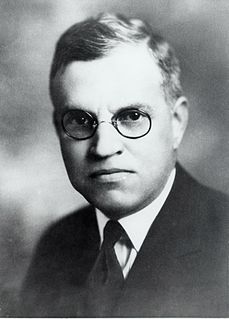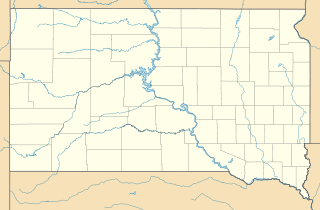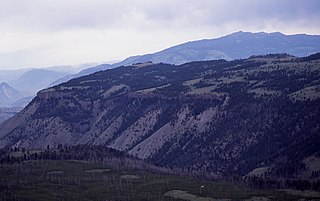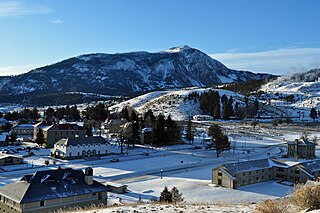Mammoth site may refer to:
Hot Springs may refer to:
Blue Springs can refer to:
Goose Creek may refer to the following places in the United States:

The Columbian mammoth is an extinct species of mammoth that inhabited the Americas as far north as the Northern United States and as far south as Costa Rica during the Pleistocene epoch. It was one of the last in a line of mammoth species, beginning with Mammuthus subplanifrons in the early Pliocene. DNA studies show that the Columbian mammoth was a hybrid species between woolly mammoths and another lineage descended from steppe mammoths; the hybridization happened more than 420,000 years ago. The pygmy mammoths of the Channel Islands of California evolved from Columbian mammoths. The closest extant relative of the Columbian and other mammoths is the Asian elephant.

Robert C. Reamer (1873–1938) was an American architect, most noted for the Old Faithful Inn in Yellowstone National Park.
A Mammoth is an extinct mammal and close relative to the modern elephant.

Obsidian Cliff, also known as 48YE433, was an important source of lithic materials for prehistoric peoples in Yellowstone National Park near Mammoth Hot Springs, Wyoming, United States. The cliff was named by Philetus Norris, the second park superintendent in 1878. It was declared a National Historic Landmark in 1996.

The Grand Loop Road is a historic district which encompasses the primary road system in Yellowstone National Park. Much of the 140-mile (230 km) system was originally planned by Captain Hiram M. Chittenden of the US Army Corps of Engineers in the early days of the park, when it was under military administration. The Grand Loop Road provides access to the major features of the park, including the Upper, Midway and Lower geyser basins, Mammoth Hot Springs, Tower Fall, the Grand Canyon of the Yellowstone and Yellowstone Lake.

The Mammoth Hot Springs Historic District in Yellowstone National Park comprises the administrative center for the park. It is composed of two major parts: Fort Yellowstone, the military administrative center between 1886–1918, and now a National Historic Landmark, and a concessions district which provides food, shopping, services, and lodging for park visitors and employees.

The North Entrance Road Historic District comprises Yellowstone National Park's North Entrance Road from Gardiner, Montana to the park headquarters at Mammoth Hot Springs, Wyoming, a distance of a little over five miles (8 km). The North Entrance Road was the first major road in the park, necessary to join the U.S. Army station at Fort Yellowstone to the Northern Pacific Railroad station at Gardiner. The road includes the Roosevelt Arch at the northern boundary of the park and winds through rolling terrain before crossing the Gardner River and joining the Grand Loop Road. The road was planned in 1883 by Lieutenant Dan Kingman of the U.S. Army Corps of Engineers and later on improved by Captain Hiram M. Chittenden of the Corps.,. It replaced the old Gardiner High Road which went from behind the Mammoth Hotel north over the ridges west of the river to the town of Gardiner. The first permanent entrance station to house rangers checking vehicle entering the park was constructed in 1921. It replaced temporary tents used by rangers at the Roosevelt Arch.
Casa Diablo may refer to several places:

The Gardner River is a tributary of the Yellowstone River, approximately 25 miles (40 km) long, in northwestern Wyoming and south central Montana in the United States. The entire river is located within Yellowstone National Park. It rises on the slope of Joseph Peak, Gallatin Range in the northwestern part of the park, and winds southeast through Gardner's Hole, a broad subalpine basin which is a popular trout fishing location. The Gardner falls within the Native Trout Conservation Area and anglers are allowed to take an unlimited number of brown and rainbow trout. Mountain whitefish and Yellowstone cutthroat trout must be released. Angling on the Gardner is governed by Yellowstone National Park fishing regulations. After merging with Panther Creek, Indian Creek and Obsidian Creek, it then turns north and flows through a steep canyon where it cuts through a basaltic flow from approximately 500,000 years ago known as Sheepeater Cliffs. Below Sheepeater, Glen Creek out of Golden Gate Canyon and Lava Creek out of Lava Creek Canyon join the Gardner near Mammoth Hot Springs. The river crosses the 45th parallel in Gardner Canyon and is also home to a popular hot spring known as The Boiling River. The river continues north through Gardner Canyon and empties into the Yellowstone near Gardiner, Montana.

The Mammoth Site is a museum and paleontological site near Hot Springs, South Dakota, in the Black Hills. It is an active paleontological excavation site at which research and excavations are continuing. The facility encloses a prehistoric sinkhole that formed and was slowly filled with sediments during the Pleistocene era. The sedimentary fill of the sinkhole contains the remains of Pleistocene fauna and flora preserved by entrapment and burial within a sinkhole. As of 2016, the remains of 61 mammoths, including 58 North American Columbian and 3 woolly mammoths had been recovered. Mammoth bones were found at the site in 1974, and a museum and building enclosing the site were established. The museum now contains an extensive collection of mammoth remains.

Mount Everts el. 7,846 feet (2,391 m) is a prominent mountain peak in Yellowstone National Park, Wyoming near Mammoth Hot Springs. The peak was named for Truman C. Everts, a member of the Washburn–Langford–Doane Expedition of 1870. Mount Everts is located immediately due south of Gardiner, Montana and due east of Mammoth Hot Springs.

Bunsen Peak el. 8,564 feet (2,610 m) is a prominent peak due south of Mammoth Hot Springs in Yellowstone National Park, Wyoming. The peak lies on the east flank of Kingman Pass on the Mammoth to Norris section of the Grand Loop Road. The peak was first ascended by Ferdinand V. Hayden and Captain John W. Barlow in 1871, Bunsen Peak was not named until 1872 during the second Hayden Geologic Survey. E. S. Topping named the peak Observation Mountain in 1872 as well, but that name did not stick. The Bunsen Peak Trail with its trailhead just south of Mammoth is a steep 2.1 miles (3.4 km) to the summit. Bunsen Peak was named for the German chemist Robert Bunsen, the inventor of the Bunsen Burner and responsible for early work on volcanic geyser theories.

Judge John W. Meldrum was a carpenter, a Wyoming politician and the first U.S. Commissioner in Yellowstone National Park, a position he held for 41 years (1894–1935).

Terrace Mountain is a mountain peak in the Gallatin Range in Yellowstone National Park in Park County, Wyoming, United States. The mountain is located 2.2 miles (3.5 km) southwest of Mammoth Hot Springs. Terrace Mountain was named by the 1878 Hayden Geological Survey because of its proximity to the travertine terraces at Mammoth and because it too is an ancient travertine terrace. The mountain has also been known as "Soda Mountain" and "White Mountain".

The Waco Mammoth National Monument is a paleontological site and museum in Waco, Texas, United States where fossils of 24 Columbian mammoths and other mammals from the Pleistocene Epoch have been uncovered. The site is the largest known concentration of mammoths dying from a (possibly) reoccurring event, which is believed to have been a flash flood. The mammoths on site did not all die at the same time but rather during three separate events in the same area. A local partnership developed around the site after the initial bone was discovered. The Waco Mammoth Foundation worked in partnership with the city of Waco and Baylor University to develop the site. Baylor's involvement mainly included the research, preservation, and storage of materials from the site, while the city of Waco contributed to the protection of the land. In 2015, they successfully sought the National Monument designation to bring the expertise of the National Park Service into the partnership.
Mammoth Spring is a large karst spring in the U.S. state of Arkansas.